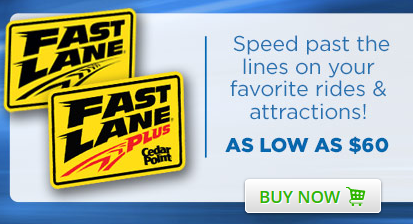Businesses like to make money. Amusement parks are a business. I get those two premises. However, I observed a lot of operational issues with Fast Passes/Fast Track/Fast Lane tickets at the amusement parks on our trip.
Fast Passes/Tracks are upgrade purchases that guests can make at a park. The Fast Pass allows you to skip some or all of the line on some or all of the rides, depending on the park and the specific version of the upgrade that you buy. We saw prices that ranged from $50 at Michigan’s Adventure to $120 at Cedar Point.
1. Some implementations of the Fast Pass idea had two lines that merged into one prior to the ride. Presumably, the Fast Pass line is always shorter than the normal line. However, this implementation requires an employee to act as traffic cop when the lines merge, a job with little added value. Other implementations keep the distinct lines all the way up to the ride itself, whereby the typical ride employees can officiate how many Fast Pass riders to allow and how many normal riders to allow. I think the second option makes more sense. First, you don’t need the extra employee. Second, normal customers feel jealousy/aggravation when their line is stopped so that Fast Pass customers can literally line jump in front of them. There’s less aggravation if the merge occurs more seamlessly at the ride itself and normal customers do not have to wait with Fast Pass customers for an extended period.
2. Some rides were saving seats for Fast Pass riders, with the Fast Pass line coming up the exit ramp to the ride. All of the rides that did this were saving too much capacity for Fast Lane. Magnum XL-200 at Cedar Point (built in 1989) was saving 4 seats for Fast Pass riders on each train. Storm Runner at Hersheypark was saving close to half the train for Fast Pass riders. In my brief wait for each ride, I didn’t see anyone come up the Fast Pass line for either ride. As such, that capacity was being left empty on the train, to the annoyance of normal waiting customers. You should only save capacity that you can routinely fill. For older rides with little Fast Pass interest, I don’t see the point in saving any capacity.
3. From a customer point of view, I would rarely decide that it was worthwhile to purchase a Fast Pass. I routinely get on every ride (that interests me) at parks in a single day. Yes, occasionally a Fast Pass will save you a one-hour wait, but you can typically get on every ride without a Fast Pass. The exception would be if you are silly enough to goto a popular park on a Saturday in the summer. Then it is crowded, and you may need a Fast Pass to ride every ride.
I think strategic thinking in terms of park dynamics is almost as valuable as a Fast Pass, and it is free. If you want to minimize your wait for rides, do the opposite of what other guests are doing. Most guests work their way from the front of the park to the back. So if it’s early in the day, the rides in the back of the park will have shorter lines. Go there first. Many rides will have shorter waits during dinner time as customers stop for food and a break. If a park has a water park, it will become crowded in the mid-afternoon, taking riders away from normal coasters.
4. Are Fast Passes fair? It’s always frustrating when a person willing to pay for extra privileges gets to do something ahead of you, after you have been waiting. I am of the opinion that everyone should wait the same duration for the same ride (and I miss days gone by when Fast Passes didn’t exist). Having said that, I understand why parks offer them. They are a means of price discrimination, getting richer customers to pay more for a slightly better experience. If I were running a park, I would get rid of Fast Passes and make up the lost revenue by moving some concession stands to the longer queues of popular rides. Concessions are price-discriminatory as well, as richer customers are more likely to buy. I would think concessions would sell well in a line where customers don’t have much else to do but wait. Concessions are less attractive in the park at large, where customers can bypass them to get to the next attraction, game, or ride. Moving concessions to the queues of long lines will more than make up for the lost revenue from eliminating Fast Passes, and “normal” customers will not be as frustrated by the presence of concessions as they are by being jumped in line by wealthy park patrons with Fast Passes. After all, line jumping is cause for ejection from the park.
————————————————————–
This discussion has been specific to the Fast Pass concepts I saw at the Cedar Fair parks and Hersheypark. I understand that Disney has a form of this as well, but it is free to everyone. I have never experienced Disney’s system myself, but from what I understand, it simply rewards strategic customers over non-strategic ones. Perhaps this is valuable to Disney because strategic customers like to game the line-skipping system and non-strategic customers don’t notice the ruse.
